Fiestas on Mallorca
Kings, Devils, Giants, Penitents and the Magic of Fire
The Fiestas in Mallorca usually have centuries-old traditions of religious origins and pagans, often mixed together. The Fiestas are an important part of Spanish culture, as they connect not only people, families, friends, village communities, but also guests and strangers in a celebration of eating, drinking and dancing all together.
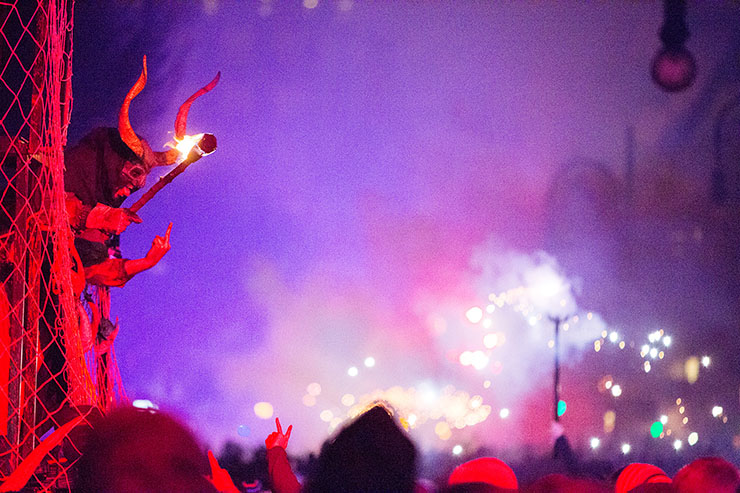
The photographer Constantin Rahmfeld has captured some of these fiestas with his camera; Reyes Magos – the arrival of the Three Kings; Sant Antoni – the feast of St. Anthony; Sant Sebastian – the feast of Saint Sebastian; the Easter processions in Holy Week and San Joan – St. John’s Night. With these photographs he has captured on film, the kings, devils, giants and penitents and has experienced the magic of fire, which plays a major role in many of these festivals.
Let Constantin Rahmfeld take you into the colourful, sometimes noisy, sometimes quiet, often mystical world of Mallorca’s Festivities, and you’ll certainly be encouraged by his expressive work and will make note of these fiesta dates on your calendar.
If you are interested in purchasing the pictures, please contact the office of Minkner & Partner in Santa Ponsa – Tel: +34 971 255 695 or send us an email
Reyes Magos – The Three Kings
The 6th of January, the Epiphany – a holiday throughout Spain – is eagerly awaited by Spanish children. In Spain, the children do not send their gift wishes for Christmas to Santa Claus, but to the Magi. According to the biblical story, the three wise men Caspar, Melchior and Balthasar, also called the wise men from the East, gave the children gifts after the visit of Christ.
On the 5thof January, the Spanish children usually put their shoes in front of the door or on the window sill, so that the Three Kings can bring them presents. They are unwrapped on the morning of 6th January (often by the very impatient on the eve of 5th January). In many Spanish villages and towns, the evening of 5th January is almost a folk festival – Christmas, New Year’s Eve and Carnival all together: In Palma, (for example,) the arrival of the Three Kings boat is announced with three cannon strikes. When Caspar, Melchior and Balthasar arrive at the Pier of La Lonja (the old stock exchange) they are greeted with applause and cheers by up to 200,000 people.
The Three Kings make their way on camels, or in a splendidly decorated car, through the city, followed by two dozen festively decorated carriages, where hundreds of the Kings servants throw sweets to the crowds.

Sant Antoni – the feast of St. Anthony
January the 17th is the names day of Sant Antoni, Saint Anthony, who is the Patron Saint of domestic and farm animals. Legend has it that St. Anthony was a wealthy man who lived in Egypt in the second half of the third century. As a Christian, he gave his entire fortune to the poor and lived as a hermit in the desert. Multiple attempts by demons to tempt him were unsuccessful. When he was dying on January 17, 356, two lions laid down beside him to guard him, whereupon Antonius blessed the lions, who later, as the story goes, buried him. Therefore, Antony is considered the Patron Saint of domestic and farm animals.
In memory of this legend, the Mallorcans celebrate “Sant Antoni”, the feast of Saint Anthony, on the night of January 16-17. In many villages, there are processions in which witches (hence the night is often referred to as a witch’s night) and the devil try to tempt St. Anthony from the right path. Antony resists and makes the sign of the cross. Out of anger, the devils are shouting” Devil come out” and they smash and throw china. In the early evening, the important prominent people of the village, accompanied by papier mache giants (Cabezudos) go to Mass in the church.
Mallorcans and their friends gather around campfires, dancing, eating and drinking. They also sing sad songs to remind them of Saint Anthony. However, as the evening progresses and alcohol consumption progresses, popular, folk lyrics gain the upper hand. Celebrations normally go on until the early hours of the morning.
On the 17th January, the locals – some on festively decorated wagons – bring their domestic animals to the church, where horses, cows, goats, sheep, pigs, dogs and cats are blessed by the local chaplain. Often, you can also see children bringing their beloved pets such as- hamsters, turtles, goldfish, cats and dogs to receive their blessing.
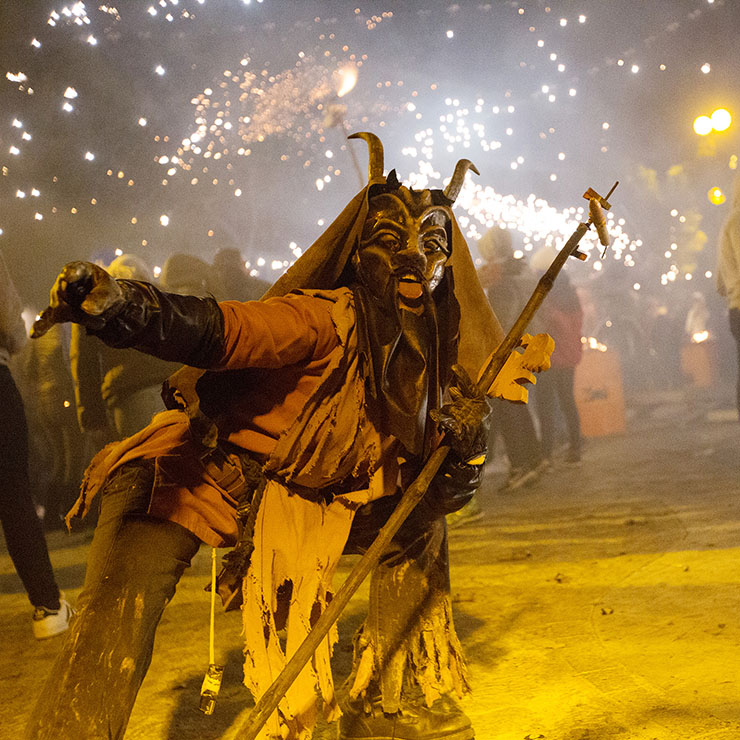
Sant Sebastian – Feast of Saint Sebastian
Palmas records show that the city was devastated in 1523 by the plague, which claimed many victims. However, the epidemic came to a sudden end as a relic (an arm bone) of Saint Sebastian (a Roman captain who attempted to convert parts of the Roman army to Christianity and was beaten to death at the behest of Emperor Diocletian in AD 288) was carried to the city. For this reason, on January 20, 1524 Saint Sebastian was appointed Patron Saint of Palma, and the Palmesans as well as the inhabitants of many other villages of the island use the memory of these events of almost 500 years ago, to honour Saint Sebastian with multiple events and fiestas.
Mostly on the 17th of January, the fireworks “Correfoc” takes place, a march of frightening devils and fire-eaters who make their way through the crowd with the help of firecrackers and flame-throwers. Protective clothing is recommended to visitors who like to attend this event. The festivities begin a few days before January 20, and actually tie seamlessly to the Fiesta in honor of Saint Anthony. The night will be especially intense from the 19th to the 20th of January. In many places in Palma and in many villages, large barbecues are installed, around which the participants of the feast bring sausages, especially the Mallorcan specialties Sobrasada and Botifarra, as well as meat and fish. These are then all put on the barbecue and everyone eats and enjoys these together. Live music is played, dancing and celebrations go on all evening.
The highlight is a fireworks display (Correfoc) of giant figures, devils, demons, fire-breathing dragons, lots of different beautiful fireworks and the smell of fire and fireworks, the drum beating musicians and bagpipe players (xeremia) give a great spectacle. The demons are then driven out of the city! At the end of the festivities, there is usually another superb firework display in Palma. The 20th of January, the actual name day, is a fiesta/holiday and gives you time to recover from the exhilarating and exhausting celebrations.
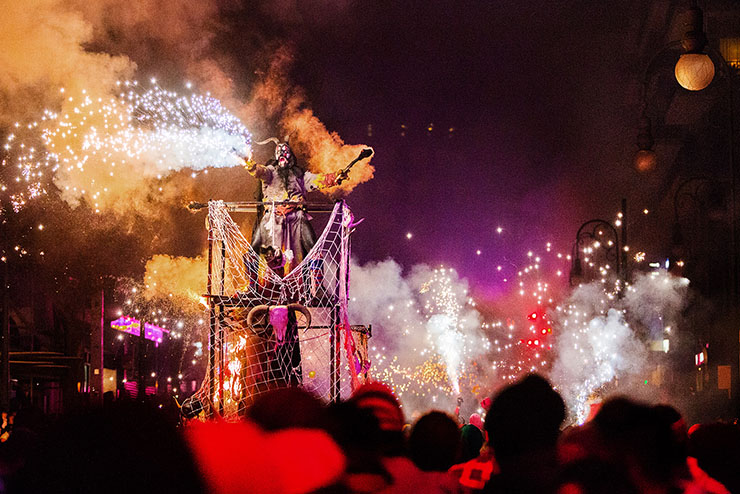
Easter procession
Easter is also one of the most important church festivals in Spain. Holy Week celebrations begin on Palm Sunday, when many devotees hang white fronds on their balconies to commemorate the entry of Jesus Christ into Jerusalem. Holy Week is also the time of the Easter processions, of which the most important ones take place on Maundy Thursday and Good Friday in the capital Palma and the villages of the island. These processions are organized by approximately fifty brotherhoods (cofraries) of the island. It is a special privilege to be a member of a brotherhood. It is usually transferred from father to son within families.
Groups of a few thousand hooded figures, with high, pointed hoods that have only eye slits, with iron chains on their feet, move silently, often barefoot, through the towns and villages, and, as penitents, trace the Passion of Christ. Some penitents carry large wooden crosses or opulent altars with saints. Because of the weight of the loads, the procession is slow. Monotonous drumbeats and melancholy brass music accompany the ghostly backdrop. A procession takes several hours.
The main procession and attraction for many believers, onlookers and tourists takes place in the evenings of Maundy Thursday in Palma. In the procession of the Holy Christ of the Blood, all the brotherhoods of Mallorca participate. It is an honour for the penitents to participate in this ceremony with the holy brotherhood. No less weighs the burden of the huge wooden crosses, which again is carried by other penitents. The mystical procession begins at the Spitalkirche, where it ends in the early morning hours of Good Friday. On Good Friday, the Calvary of Pollenca is the meeting point of the penitents and the faithful. At the beginning of the day a huge wooden cross is erected on the mountain. During the day, oil lamps and torches are lit on the 365 steps that lead to the top. In the evenings, monks then remove the statue of Christ from the cross, wrap it in white linen and carry it down the 365 steps to the parish church.
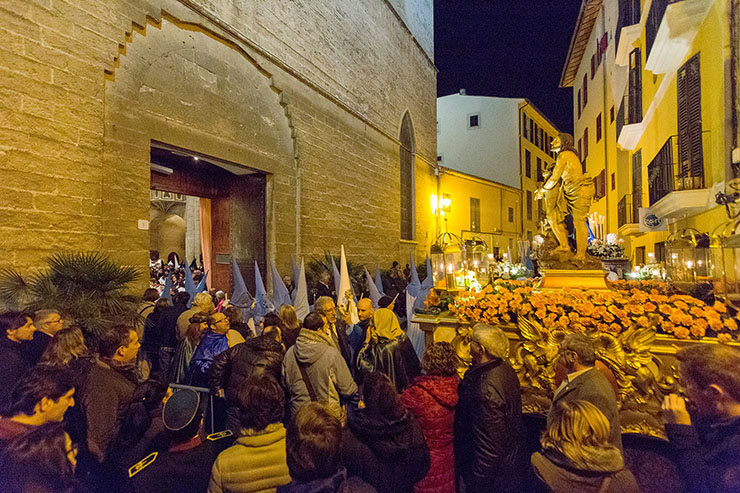
Es Firo Fight Spectacle between the Moors & the Christians at Port de Soller
Es Firo – this spectacle always takes place on the Monday after the second Sunday in May. A state of emergency prevails in Soller and Port de Soller as the fight between the Moors and Christians festival is celebrated. This is in memory of the heroic defence of the Port during an attack by Turkish and Algerian pirates in 1561, it is a reminder of the festival in Oberammergau when the youth of the little town (approximately 4,000 participants), dressed in elaborately designed costumes as Moors and Christians, deliver a tumultuous battle with wooden swords, shotguns and slingshots, from which the Christians finally emerge as victors. The deafening result: 40 kilos of black powder are used annually and 12,000 rifle salvos are fired. Unlike in history, when the battle is over, people fall into each other’s arms and dance, play and listen to music and celebrate the great fun time together. Around the battle there is a big folk festival with numerous stalls with goods of the region and handicrafts, exhibitions of agricultural machinery and farm animals. Not for nothing – this is well known as the most important annual event in Soller and Port de Soller.
San Joan – St. John’s Night
On the night of June 23rd to 24th, Mallorca celebrates San Joan, St. John’s Night. It is the night of the summer solstice, the shortest, probably the most atmospheric night of the year. Although it is also a Memorial Day for John the Baptist, the actual root of celebration of the night of St. John is founded before Christ.
Mallorcans congretate on the beaches with the whole family for picnics by the campfire, food baskets are unpacked and candles are lit to create a festive atmosphere. Small paper boats with candles are put into the sea, hoping to drive away the evil spirits. Others write their wishes or, what they want to change in the future, on paper and throw the wish list into the fire. They then jump over the fire three times and pray their wishes hopefully come true. You can also throw three coins into the sea as an added security for your wishes. Others put on white clothes and at midnight, at the witching hour, take a bath to cleanse body and soul. Many also believe in St.Johns Night to find out whether a desire for a child will soon come true: You place a tealight in a small boat – if the light burns long and the boat does not sink, the desire for children will soon come true.
In the villages and towns – especially Palma, Calvia, Deia, Muro, Felanitx, Son Servera and Sant Joan – this fiesta is celebrated until the early morning. There are open-air live concerts, arts and crafts markets, barbeques, drinks and in Palma the beloved “Correfoc” the devil dancers, in which about 200 fire devils, with firecrackers and with lots of noise, accompanied by about 100 musicians, parade through the streets.
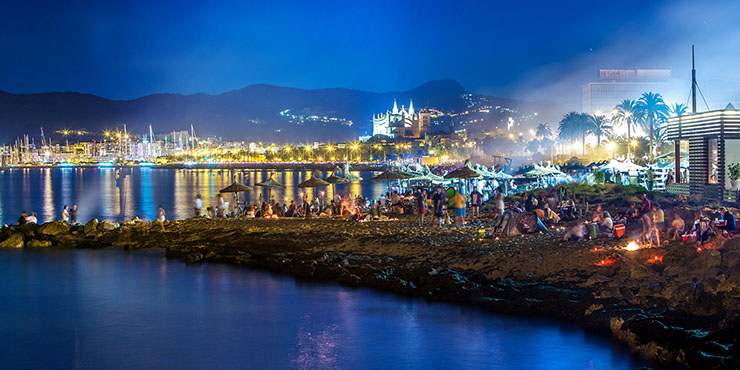
Virgen del Carmen – the festival of the patron saint of the sea
The charming harbour village of Port Andratx, which is surrounded by hillsides, luxurious villas and residential developments, forms the backdrop for the festival in honour of the “Virgen del Carmen”, the patron saint of the fishermen and the sea, which is traditionally held in Port Andratx on 16th of July each year. A statue of the Virgin is festively decorated and is carried by church dignitaries from the church to the port. From there on, it is put on a ship and then leads the accompanying boats, ships and yachts from the harbour to the sea and back again. With the sounds of sirens and foghorns the patron saint is greeted and honoured. The festival begins at noon and continues until late in the evening. There is music, a street festival, a horse show along the harbour promenade, the dance of the demons “correfoc”, where the artists make noise and let off steam with drums and fireworks. The spectacle can also be observed from the numerous terrace restaurants. One should reserve in time, because the best seats are always in great demand.
Festes del Rei En Jaume – Feast of the recapture of Mallorca by King Jaume I
During the first two weeks of September, Santa Ponsa celebrates the fiesta commemorating the reconquest of Mallorca by Jaime I and the liberation of Mallorca from the Arabs. The event dates back 800 years: on 11 September 1229, the Christian King Jaume I, arrives in Santa Ponsa with his Armada of 150 ships and 13,000 soldiers after a hard battle having defeated the Muslim occupiers. Three months after arriving, on 31st December 1229, he finally entered Palma with his troops. The Mallorcans and their guests celebrate this historic event, which is important for the island, with a traditional medieval market, street theatre, concerts as well as costumed parades. On September 11th, the arrival of the Jaume I army in the bay of Santa Ponsa and the ensuing battle between the conquerors and the occupying forces is re-enacted by amateurs and actors. In the evening there is a big party where you can enjoy the live music, the fire-breathing demons and their fire dance “Correfoc” (put on fireproof clothes or keep your distance!) plus a huge firework display on the beach.
Fiesta del Vermer – the Wine Festival in Binissalem
Every year during the the last two weeks of September, (with its peak being on the last Sunday in September) the wine festival “Fiesta Vermer” takes place in Binissalem. As well as being internationally recognized, for more than 50 years(!) the small wine village has been under the sign of wine. The streets are festively decorated, the neighbours put their tables in front of the house and eat and drink traditional dishes and drink the young wine together. There are traditional costume and music parades through the streets, and near the sports centre there is a battle of the grapes: Hundreds of tons of surplus and unusable grapes are carted into the square where the young villagers fight a battle by throwing berries and grapes at each other. A rather sticky affair!! It is not for nothing that the town hall administration sets up shower cubicles where you can clean up after the battle. There is also the traditional grape treading on the church square where with bare feet the grapes are trodden in the wooden vats, just as the grapes were “pressed” centuries ago. The “Correfoc” parade is also particularly popular, in which artists dress up as demons and ignite fireworks and perform dangerous fire dances. In short: The Fiesta del Vermer is a wine festival that should not be missed!
Dijous Bo (Good Thursday) – The popular farmers market in Inca
Every 3rd Thursday in November a state of emergency prevails in Inca in the middle of the island. The popular farmers’ market Dijous Bo, Mallorca’s largest market event, is open and attracts an average of 100,000 visitors. Dijous Bo is not just a market, it is an agricultural fair, a sales show by Mallorca’s farmers and craftsmen, a weekly market and a funfair all in one. You can taste, try and buy everything that is grown and produced in the region at hundreds of stalls: the sobrasada sausage, the good wines from Binissalem, Consell and Porreres, olive oil, honey and herbs, local cosmetics and handicrafts made of leather, wood, clay or glass, and jewellery. In addition, the farmers present their animals: goats, sheep, cows, pigs and chickens. Producers present the latest machinery for agriculture. There will also be live music, dance performances, performances, children’s animation, workshops and exhibitions. The farmers market is held in the village centre, handicrafts and crafts are presented in the market hall, animals can be admired in the Placa del Bestiar, and plants and flowers can be bought in the Placa d`Espanya. Inca’s gastronomy also wants to contribute to the occasion and offers tapas and other traditional dishes, various Mallorcan wines on terraces as well as in the restaurants and cellers.


 Deutsch
Deutsch Español
Español